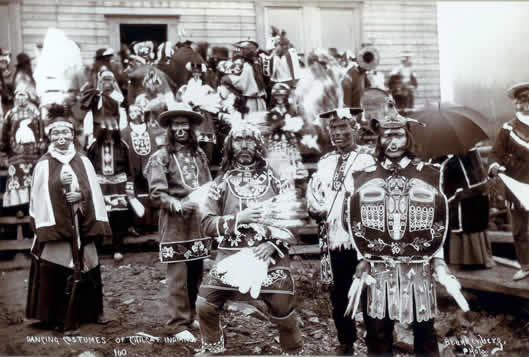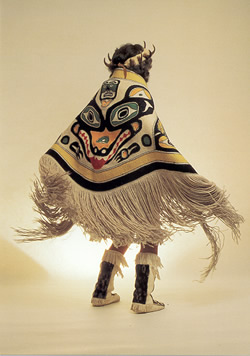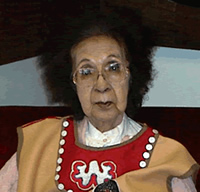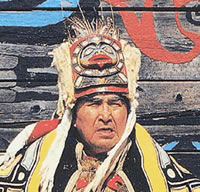
Dance, for the Tlingit people, is a means of expression and communication, and a form of enjoyment. It is a major potlatch activity, or, as in the old days, it could be an impromptu performance around the evening fire. The shaman used dance as a vehicle to make contact with the spirit world; regular folks might tell a story, ridicule an opponent, or extend an apology through a combination of dance motions. Drums and carved rattles were used as accompaniment.

Master Weaver Jennie Thlunaut’s last Chilkat Blanket, modeled by her daughter, Agnes Bellinger © 1985 Marilyn Holmes.
Dance regalia is magnificent. Masks representing creatures of the natural and mythical worlds are exquisitely carved and painted. Elaborate headdresses allow the dancer to shower guests with goose down by means of a carved frontlet capped with upright sea lion whiskers and bird feathers which provides a space in which to tuck the down. As the dancer gyrates, the down is shaken about, symbolizing a gesture of hospitality and good wishes.
Beautiful Chilkat blankets are used as dance robes. The fringe provides a wonderful visual effect as the dancer moves. (The Tlingit name for the Chilkat blanket is Naxein, meaning “fringe about the body.”) Other dance blankets were beaded, appliquéd, or adorned with buttons arranged in pleasing designs. Dance shirts made from Hudson’s Bay blankets were likewise decorated.
Tlingit dance tradition continues here in the Chilkat Valley kept alive by local native dance troupes.
Barbara Waterbury, 1987
Interviews with Two Local Dancers

Elsie Mellot
ELSIE MELLOT
Elsie Mellott is a member of the Eagle clan. She sangs and danced with the Gei-Sun Dancers of Haines. Elsie passed away in 2006.
- Q: When did you begin dancing, Elsie?
- A: I picked it up as a child. In my days it was easy to pick up because so many people danced. Both my mother and father danced. Nowadays they have to learn. There were lots of dances when I was young–for potlatches and shows, things like that.
- Q: Is there any dance event that is especially memorable for you?
- A: When I was young a group from Klukwan would dance at the ANB (Alaska Native Brotherhood) Hall in Haines. I remember they did a dance to show how things were long ago. There was a funeral–with the corpse dressed in full funeral regalia sitting with his back against the wall–and a man dancing the part of the widow. He would wail and throw himself on the corpse, and while he was there he would tickle. Pretty soon the corpse was sitting there grinning. I thought that was funny. I remember another dance they did showed the first time the Tlingits saw the white men. They had to look at them through some object because it was dangerous to look right at a white man. The old timers were really good.
- Q: Where do you get your dance regalia?
- A: I made my button blanket–with help. Mine is the Killer Whale design. I made my headband too. My dress has the Wolf design. It’s really my brother’s dance shirt, but it fits me as a dress. The men wear Chilkat blankets for some of the dances.
- Q: What are the roles of the men and women during the dances?
- A: The women mostly sing and sway. They don’t move around as much as the men. Women don’t move their feet unless they are dancing a part that’s for the women.
- Q: The Gei-Sun dancers were invited to dance in Hawaii last year. How was that?
- A: It was really nice. When we landed in Hawaii we decided to sing a Tlingit song for our host who was picking us up at the airport. You know how noisy it is at airports. Well, we started to sing and suddenly it was perfectly quiet. Everyone was listening.

Charlie Jimmie, Sr.
CHARLIE JIMMIE, SR.
Charlie Jimmie, Sr. belongs to the Raven clan. He has danced with the Chilkat Dancers of Haines for approximately 25 years and with the Gei-Sun dancers since they were organized back in the 60s.
- Q: When did you start dancing, Charlie?
- A: When I was four years old. When I came here from Yakutat.
- Q: Why do you dance?
- A: I love to perform — to dance. It’s in my blood, like jitterbugging used to be for the youngsters. It also makes me feel proud. When I was down south I saw a friend of mine–big fellow 6’3″, a Plains Indian — dance. When he danced he held his head up like this and was proud. It made me proud.
- Q: Did you notice any similarities?
- A: With Tlingit dancing the energy is very concentrated. If the dancer is [portraying] a halibut, then all his movements are only those of a halibut.
Bibliography:
Billman, Esther. Tlingit Bulletin Number 1. Sheldon Jackson Museum Press, Sitka. 1975.
Jonaitis, Aldona. Art of the Northern Tlingit. University of Washington Press, Seattle. 1986.
Kaiper, Dan & Nan. Tlingit: Their Art and Culture. Hancock House Publishers, Seattle. 1978.
Krause, Aurel. Erna Gunther, Translator. The Tlingit Indian, University of Washington Press, Seattle. 1885.
Samuel, Cheryl. The Chilkat Dancing Blanket. Pacific Search Press, Seattle. 1982.
